Five Steps to B2B Payments Automation

B2B payments automation is the last mile of accounts payable.
Automating manual tasks cuts the time and resources required for monthly vendor payment runs. It removes bottlenecks and provides complete control and visibility over payment processes to help your business pay vendors on time and improve working capital management.
In Episode 36 of the Leaders of Modern Finance podcast, host Ben Murray, Founder of The SaaS CFO, joins Simone Nardi, CFO at G-P, to discuss how CFOs can lead by creating systems in advance of large organizational transitions. Many companies have invested in automating accounting processes to reduce costs and build efficiencies. However, many more still need to pay attention to how and when they pay suppliers.
Maybe payments automation is a new idea to your company, and you’re still using manual processes to pay vendors. Or maybe you’re considering your options, and want to approach digital transformation the right way.
This guide discusses the benefits of business-to-business payments automation and presents five strategies to make the most out of automating payments processing. You should walk away with insights on implementing payment automation for your business. With the right fit, your business can reduce AP processing costs, eliminate late payments, boost payment accuracy, and take control of your cash flow.
Let’s dive in.
What is B2B payment automation and how does it work?
In AP in 2023: Expectations, Technology, Opportunity, Stampli surveyed CFOs and finance leaders across the US on the changes they expect to see in accounts payable. Seventy-two percent (72%) said they plan to increase the use of electronic payments in 2023.
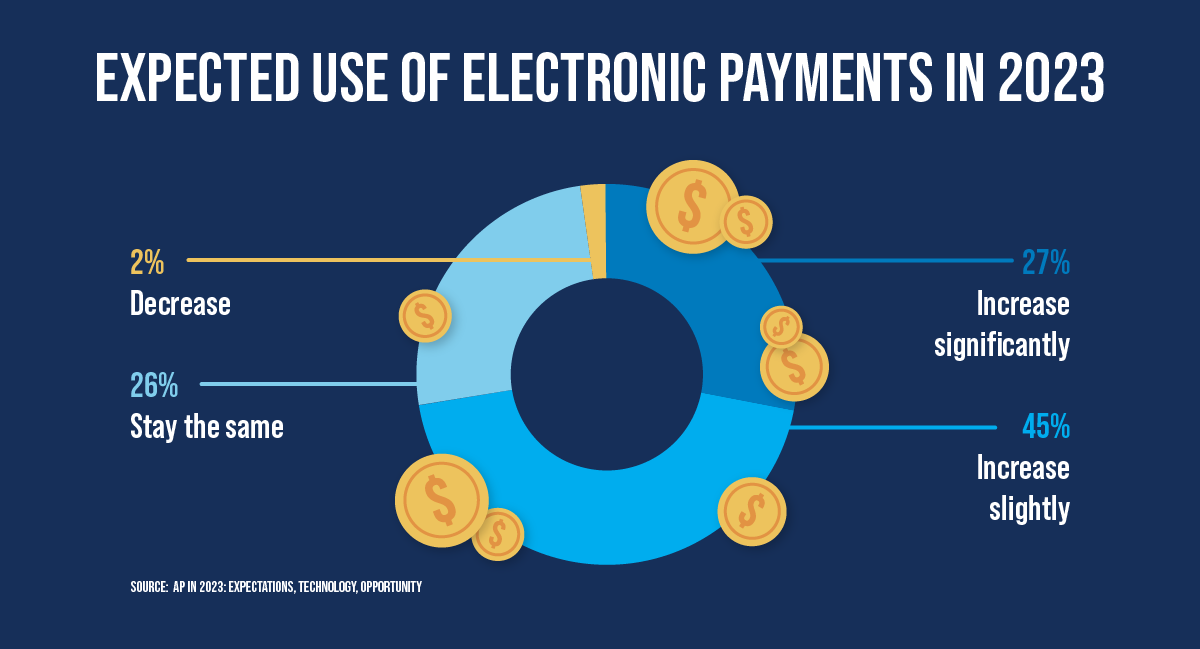
B2B payment automation is a software solution that streamlines payment processing and enables businesses to send and receive electronic payments. Unlike manual B2B payment processing, automation organizes invoices, routes payments for approval, and completes payment runs, all without human intervention. Some payment automation solutions also help you earn cash rebates, record and organize transactions, and provide real-time financial reporting.
Types of B2B payment methods
Most B2B automation solutions provide access to a wide range of traditional and digital payment options, including:
Check: automated or outsourced physical check printing, approval, and mailing services
Wire transfer: domestic and international (SWIFT) wire transfers
ACH: US and overseas transfers over the Automated Clearing House system and Global ACH system
Credit card: Traditional commercial credit card services like Visa or MasterCard or Stampli Card
Virtual card: “Cardless” virtual payment card services like Stampli Card
Peer to peer: Online real-time payment services like PayPal, Venmo, Square, and Stripe
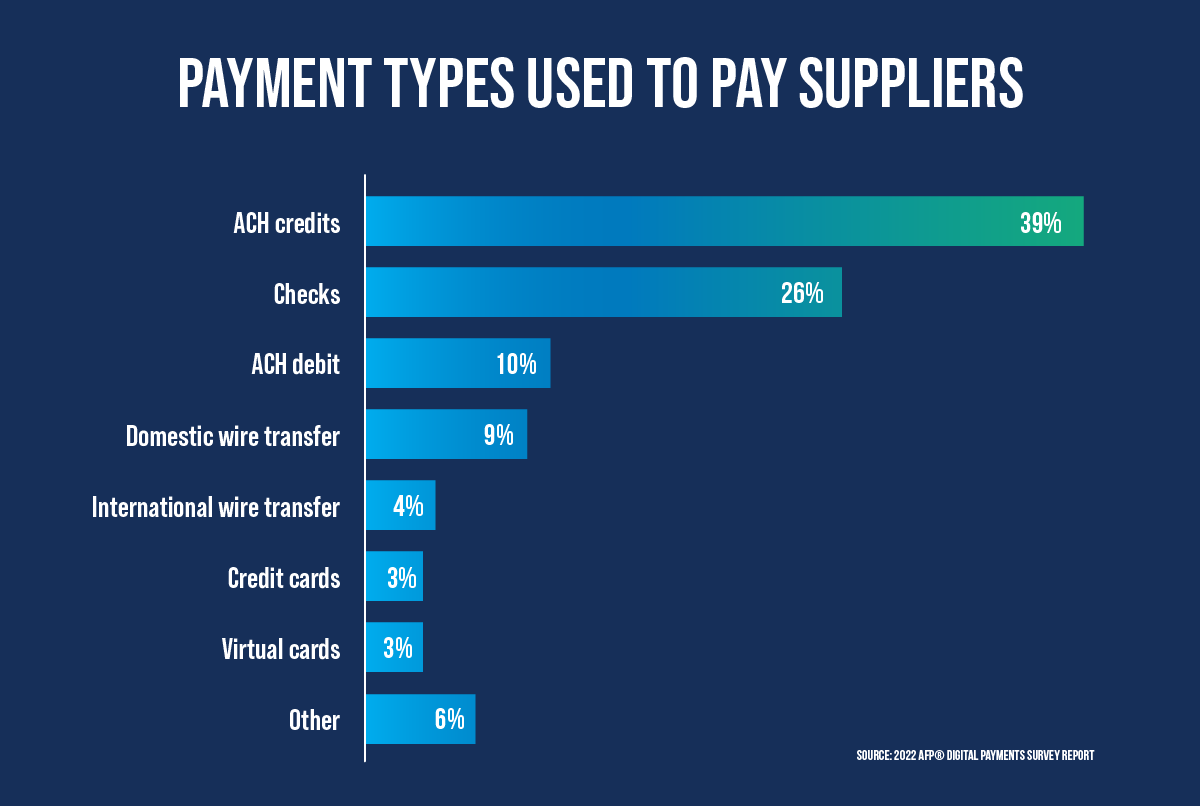
The goal of B2B automation is to improve payment times, reduce fraud and human error, and create positive working relationships between companies. Accounts payable teams no longer need to rely on manual paper-based payment processes.
Benefits of automating B2B payments
Switching to automated payments saves companies time and money. They also lead to happier contractors and vendors and a greater possibility of them agreeing to vital but sometimes-elusive early payment discounts since they’re getting paid sooner.
Let’s break out these and the other benefits of B2B payments automation.
Save time and money
By replacing time-consuming manual processes, B2B payment automation means AP teams no longer have to enter payment data or track due dates manually. This reduces labor costs and frees up employees’ time to focus on higher-value tasks.
Error & fraud prevention
Manual payment processes are error-prone and vulnerable to fraud. Automation solutions virtually eliminate invoice processing errors. Also, most B2B payment solutions provide security features to enforce internal controls and protect against payments fraud.
Improve cash flow management
Automating payments gives you more visibility into your payments processes. You can anticipate future expenditures and make informed decisions to maximize working capital.
Pay vendors on time
Faster payment processing means paying vendors on time and avoiding late fees. It also lets you pay early and earn early payment discounts from vendors.
Simplify auditing and reporting
By centralizing accounts payable and accounts receivable processes via common workflows, you can easily capture payment and transactions data. Access to this information helps you trace the status and timing of incoming and outgoing payments and manage cash flow.
You need to take a strategic approach to B2B payments automation to achieve these benefits. Here are five strategies you can follow to get started.
1. Select and implement a B2B payments automation solution
Follow this four-step process to select and implement the right payments automation solution for your business.
Step 1: Review your current vendor payments processes
Begin by evaluating how you currently process payments, what tools you use, and where the bottlenecks and inefficiencies are. Pay special attention to these metrics:
- Types and timing of payments: how you pay vendors, compliance with payment terms, discounts available and taken
- Reason for choosing payment type: do you choose by vendor preference, costs, or other reasons? How do your vendors want to be paid?
- Actual costs of payment types: what’s the per transaction cost for each type (fees, labor, postage)?
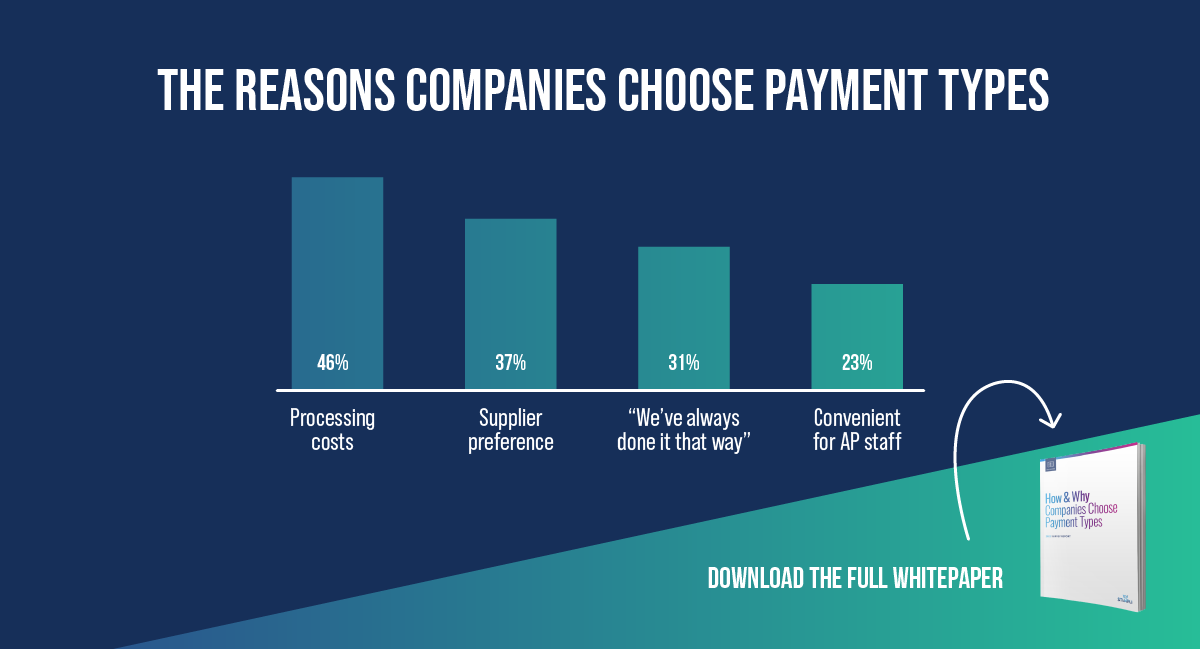
This information will help you evaluate platform features and capabilities and calculate the ROI of implementing different platforms.
Step 2: Select an automation vendor
Once you’ve identified areas where you can automate payments processing, choose a payment automation provider. Here are some tips for choosing the right solution:
- Flexibility: How many payment types does the vendor offer? Does it lock you to a certain type? Do you need to make international payments?
- Integration: Does the platform integrate with your existing ERP or accounting software?
- Customer service: What are users saying about the usability and customer support the provider offers?
- Reporting: Does the platform record data and perform analytics to automate reporting accounts payable KPIs?
Step 3: Implement the payment automation solution
After you choose a solution, you’ll need to implement it in your business. Implementation typically involves:
- getting employees set up on the platform
- connecting your bank accounts
- adding your vendor’s payment information, and
- setting up approval and payment workflows.
Step 4: Test the solution
Once you’ve implemented the payments solution, test it to ensure it works correctly. Testing will help identify and correct issues before they become an expensive problem. For example, you may want to test the platform’s ability to handle foreign exchange transactions, recurring payments, or batch payments.
2. Reduce check use by switching to ACH transfers
According to the Association of Finance Professionals, 26% of North American businesses still used paper checks in 2022, down from 42% in 2019. Although check usage is declining, checks remain the second most common form of B2B payment.
Unfortunately, checks are also one of the slowest and most expensive forms of B2B payment. In contrast, ACH payments cost between 26 and 50 cents per transaction. Look at what percentage of vendors you pay by check and consider speaking to them about moving to electronic payment methods.
Even if you’ve got vendors that prefer paper checks, a good payment automation solution can make paying by check more efficient. The software stores your vendor data after it’s entered (the first time) and keeps it in a centralized location with other payment information. Plus, it gives you the option to process checks in batches to reduce processing time.
3. Maintain an accurate and complete audit trail
Your audit trail is the record of all transactions, actions, and communications in your AP workflows. It helps auditors detect errors, assures regulatory compliance, and supports your internal controls.
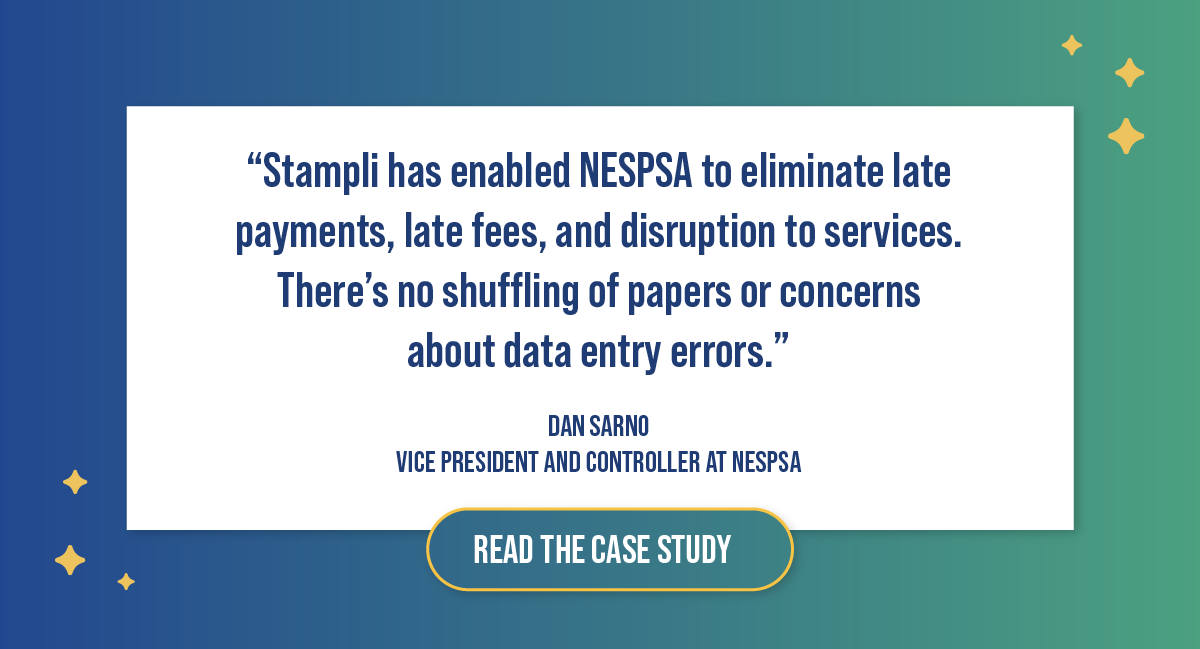
Payments automation improves your audit trail by automatically collecting and recording every transaction detail. You can track and monitor transactions in real time to prevent fraud and detect duplicate payments and other errors.
4. Encourage vendors to accept virtual cards
Some B2B payment automation platforms offer virtual cards as a payment method. Virtual card payments are instantaneous and have very low transaction costs. They also provide a high degree of security and control over vendor payments.
Many virtual cards offer cash rebates on transactions. The revenue from these rebates can offset processing costs and even turn a profit for your vendor payments process.
Speak to your vendors about switching to virtual card payments. Vendors may be reluctant to accept virtual card payments because of the associated merchant fees. However, they will be paid faster with virtual cards, providing them with immediate cash for operations. You can also offer shorter payment terms to convince vendors to switch to virtual cards from other payment types.
5. Combine payment automation with AP automation solution
Manual invoice processing is slow and prone to errors that can cause payment delays. To get the most value out of your payment automation solution, consider combining it with an accounts payable automation solution. By streamlining manual AP workflows, you’ll improve payment times and reduce erroneous payments.
AP automation software automates invoice data entry. After validating the invoice data against the purchase order, the AP platform sends the invoice for approval. Once the invoice is approved, the platform forwards the invoice data to your payment system.
To begin automating your accounts payable processes, choose an AP automation solution that integrates with your chosen payment platform. The solution should be fully customizable and integrate easily with your existing ERP and accounting systems.
Simplify B2B payments automation with Stampli Direct Pay
It’s time to invest in your company’s bottom line by improving the productivity of your AP team and your suppliers’ AR teams.
Optimizing the value of Accounts Payable means conquering the last mile of AP. Payments optimization means you have visibility into what you are doing and why you are doing it, so you can choose the optimal payment methods, invest in vendor relationships, and deliver a frictionless procure-to-pay process.
Stampli Direct Pay lets you take complete control of your B2B payments. It’s a payment-agnostic solution that streamlines your payments process and gives you total freedom to pay vendors however you want.
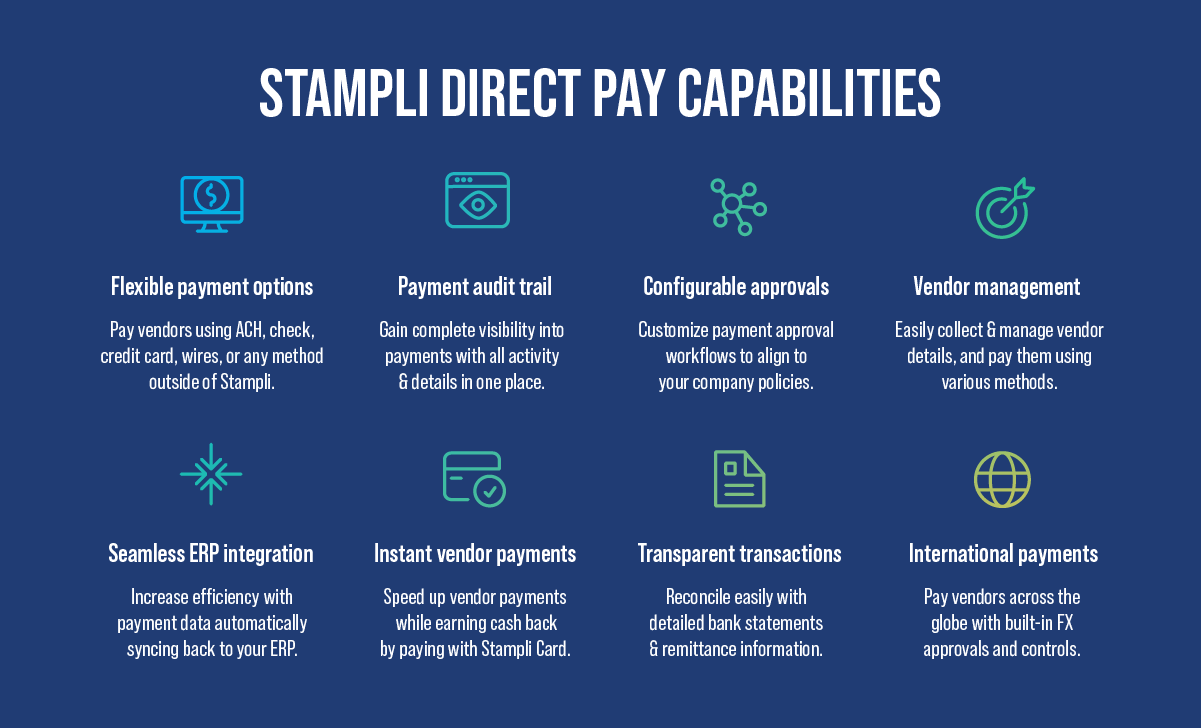
Direct Pay integrates seamlessly with over 70 ERPs and accounting software providers, ensuring everyone in your company can access accurate business data anytime.
Here’s how Stampli Direct Pay simplifies B2B payments automation:
Payment agnostic
Pick the electronic payment type you and your vendors prefer.
Simplified payment approvals
View payment information and supporting information to make payment approvals easy.
Centralized vendor management
With Stampli Advanced Vendor Management, suppliers can enter their banking information, choose their payment type, and check payment status via an online portal.
International payment flexibility
Save on transaction fees, manage currency risk, and pay overseas suppliers quickly and securely.
Simplify your B2B payments today. Contact Stampli for a free demo of Stampli Direct Pay.